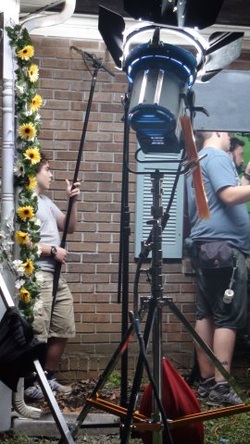sound + tools + education

Training students in production sound --all aspects-- is made possible due to years of experience, mistakes, and perseverance.
By focusing on the sound and its dominant importance in content, Mr. Ball has been able to reshape the prejudices many have about sound: that it takes just a short time to set up, things can be fixed later, and there's no reason to carry headphones around.
Emphasizing readiness in skill and knowledge of gear, Sound Production classes now cover the gamut of audio-for-video, with hands-on projects every week of the entire semester.
Having experience with analog tape, pilot tone, and film cameras has served anyone well who works in today's instant-gratification digital environs. However, many who have this experience do not embrace the evolution of the craft and bemoan the loss of the old school. Instead, having no allegiance to either camp, but emphasizing the use of the appropriate tool for the job at hand, Mr. Ball teaches (and lives) both worlds from an entirely pragmatic approach. He puts continuous emphasis on the importance of feeling very comfortable with the basics, then putting them to work in hands-on. "There are two types of fools: one says 'this is old, and therefore better; the second says 'this is new, and therefore better'."
Mr. Ball is currently using his writings in class, and is in process of writing "The Recording Studio Advisor", a textbook about how to achieve the art of recording performances, how to hear; not technical lists, techniques, or what equipment to buy and desire.
By focusing on the sound and its dominant importance in content, Mr. Ball has been able to reshape the prejudices many have about sound: that it takes just a short time to set up, things can be fixed later, and there's no reason to carry headphones around.
Emphasizing readiness in skill and knowledge of gear, Sound Production classes now cover the gamut of audio-for-video, with hands-on projects every week of the entire semester.
Having experience with analog tape, pilot tone, and film cameras has served anyone well who works in today's instant-gratification digital environs. However, many who have this experience do not embrace the evolution of the craft and bemoan the loss of the old school. Instead, having no allegiance to either camp, but emphasizing the use of the appropriate tool for the job at hand, Mr. Ball teaches (and lives) both worlds from an entirely pragmatic approach. He puts continuous emphasis on the importance of feeling very comfortable with the basics, then putting them to work in hands-on. "There are two types of fools: one says 'this is old, and therefore better; the second says 'this is new, and therefore better'."
Mr. Ball is currently using his writings in class, and is in process of writing "The Recording Studio Advisor", a textbook about how to achieve the art of recording performances, how to hear; not technical lists, techniques, or what equipment to buy and desire.
Writing

Waves began in Tel-Aviv, then took its first breath in Knoxville. Three people made the company come alive, and every chore had to be done by one of those three. Since Mr. Ball was the only fluent English speaker and conveniently had more than a decade of writing for radio behind him, he was put to task writing every press release, brochure, and owner's manual for the new company. This was in addition to being the dev and alpha tester, and charged with running the external beta process.
In all, fourteen "User's Guide" manuals were developed, dozens of trades shows attended, large-scale signage was designed and printed (usually by former Whittle employees), videos were produced, user interfaces were designed or modified, web articles were created, and millions of pixels tweaked by Mr. Ball during his association with the company. His work with all aspects of media --books, magazines, web graphics, audio demonstrations, video tours, and interactives-- has generally hammered home the importance of the fundamentals to the total quality of the end product.
Below is one of the fourteen User Guides written by Mr. Ball.
In all, fourteen "User's Guide" manuals were developed, dozens of trades shows attended, large-scale signage was designed and printed (usually by former Whittle employees), videos were produced, user interfaces were designed or modified, web articles were created, and millions of pixels tweaked by Mr. Ball during his association with the company. His work with all aspects of media --books, magazines, web graphics, audio demonstrations, video tours, and interactives-- has generally hammered home the importance of the fundamentals to the total quality of the end product.
Below is one of the fourteen User Guides written by Mr. Ball.
Your browser does not support viewing this document. Click here to download the document.
